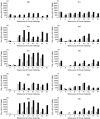Vaccination of neonatal calves with Mycobacterium bovis BCG induces protection against intranasal challenge with virulent M. bovis
- PMID: 15606613
- PMCID: PMC1809274
- DOI: 10.1111/j.1365-2249.2005.02668.x
Vaccination of neonatal calves with Mycobacterium bovis BCG induces protection against intranasal challenge with virulent M. bovis
Erratum in
- Clin Exp Immunol. 2005 Apr;140(1):192
Abstract
Vaccination of neonates with Mycobacterium bovis bacillus Calmette-Guerin (BCG) may be a strategy that overcomes reduced vaccine efficacy associated with exposure to environmental mycobacteria in humans and cattle. Preliminary comparisons indicated that 2-week-old calves produced an immune response to vaccination at least as intense as that observed in adults. Subsequently, five gnotobiotic hysterotomy derived calves aged 1 day were inoculated with BCG and 3 months later were challenged intranasally with virulent M. bovis. The number of tissues with lesions and the pathological extent of these lesions was reduced significantly in vaccinates. Furthermore, lesions were evident in the lung or associated chest lymph nodes of four of five controls but none of five vaccinates. BCG vaccination reduced significantly the level of bacterial colonization. However, lesions in the head associated lymph nodes were observed in three of five BCG-vaccinated cattle. Levels of interferon gamma (IFN-gamma) detected by enzyme-linked immunosorbent assay (ELISA) or enzyme-linked immunospot (ELISPOT) in individual vaccinated animals at challenge did not correlate with subsequent resistance and in general immune responses post-challenge were lower in vaccinated calves. Low IL-10 responses were evident but IL-4 was not detected. Responses to ESAT-6 and/or CFP-10 were evident in four of four control calves that had lesions. Two of the BCG vaccinates with lesions did not produce a response to ESAT-6 and CFP-10, indicating that these antigens did not distinguish vaccinated immune animals from vaccinated animals with lesions. Overall, vaccination of neonatal calves with BCG induced significant protection against disease and has potential as a strategy for the reduction of the incidence of bovine tuberculosis.
Figures



Similar articles
-
An ESAT-6:CFP10 DNA vaccine administered in conjunction with Mycobacterium bovis BCG confers protection to cattle challenged with virulent M. bovis.Vaccine. 2007 Jun 11;25(24):4735-46. doi: 10.1016/j.vaccine.2007.03.052. Epub 2007 Apr 24. Vaccine. 2007. PMID: 17499400 Clinical Trial.
-
Consequence of prior exposure to environmental mycobacteria on BCG vaccination and diagnosis of tuberculosis infection.Tuberculosis (Edinb). 2008 Jul;88(4):324-34. doi: 10.1016/j.tube.2007.12.002. Epub 2008 Mar 7. Tuberculosis (Edinb). 2008. PMID: 18329343
-
Immunohistochemical markers augment evaluation of vaccine efficacy and disease severity in bacillus Calmette-Guerin (BCG) vaccinated cattle challenged with Mycobacterium bovis.Vet Immunol Immunopathol. 2006 Jun 15;111(3-4):219-29. doi: 10.1016/j.vetimm.2006.01.016. Epub 2006 Mar 15. Vet Immunol Immunopathol. 2006. PMID: 16540176
-
Identification of immune response correlates for protection against bovine tuberculosis.Vet Immunol Immunopathol. 2005 Oct 18;108(1-2):45-51. doi: 10.1016/j.vetimm.2005.08.002. Vet Immunol Immunopathol. 2005. PMID: 16140388 Review.
-
[Novel vaccines against M. tuberculosis].Kekkaku. 2006 Dec;81(12):745-51. Kekkaku. 2006. PMID: 17240920 Review. Japanese.
Cited by
-
Bovine tuberculosis in youngstock cattle: A narrative review.Front Vet Sci. 2022 Sep 23;9:1000124. doi: 10.3389/fvets.2022.1000124. eCollection 2022. Front Vet Sci. 2022. PMID: 36213413 Free PMC article. Review.
-
Defined Antigen Skin Test for Bovine Tuberculosis Retains Specificity on Revaccination With Bacillus Calmette-Guérin.Front Vet Sci. 2022 Apr 13;9:814227. doi: 10.3389/fvets.2022.814227. eCollection 2022. Front Vet Sci. 2022. PMID: 35498753 Free PMC article.
-
Efficacy and Safety of BCG Vaccine for Control of Tuberculosis in Domestic Livestock and Wildlife.Front Vet Sci. 2018 Oct 26;5:259. doi: 10.3389/fvets.2018.00259. eCollection 2018. Front Vet Sci. 2018. PMID: 30417002 Free PMC article. Review.
-
Duration of immunity against Mycobacterium bovis following neonatal vaccination with bacillus Calmette-Guérin Danish: significant protection against infection at 12, but not 24, months.Clin Vaccine Immunol. 2012 Aug;19(8):1254-60. doi: 10.1128/CVI.00301-12. Epub 2012 Jun 20. Clin Vaccine Immunol. 2012. PMID: 22718125 Free PMC article.
-
Unveiling insights into bovine tuberculosis: A comprehensive review.Open Vet J. 2024 Jun;14(6):1330-1344. doi: 10.5455/OVJ.2024.v14.i6.2. Epub 2024 Jun 30. Open Vet J. 2024. PMID: 39055751 Free PMC article. Review.
References
-
- Colditz GA, Berkey CS, Mosteller F, et al. The efficacy of bacillus Calmette–Guérin vaccination of newborns and infants in the prevention of tuberculosis: meta-analyses of the published literature. Pediatrics. 1995;96:29–35. - PubMed
-
- Fine PE. Variation in protection by BCG: implications of and for heterologous immunity. Lancet. 1995;346:1339–45. - PubMed
-
- Palmer CE, Long MW. Effects of infection with atypical mycobacteria on BCG vaccination and tuberculosis. Am Rev Respir Dis. 1966;94:553–68. - PubMed
-
- Black GF, Dockrell HM, Crampin AC, et al. Patterns and implications of naturally acquired immune responses to environmental and tuberculous mycobacterial antigens in northern Malawi. J Infect Dis. 2001;184:322–9. - PubMed
Publication types
MeSH terms
Substances
LinkOut - more resources
Full Text Sources
Other Literature Sources
Medical
Miscellaneous

